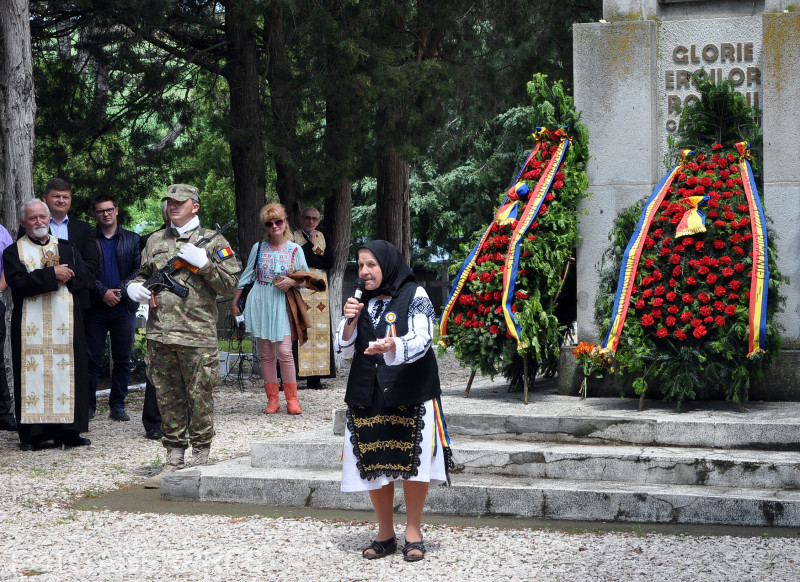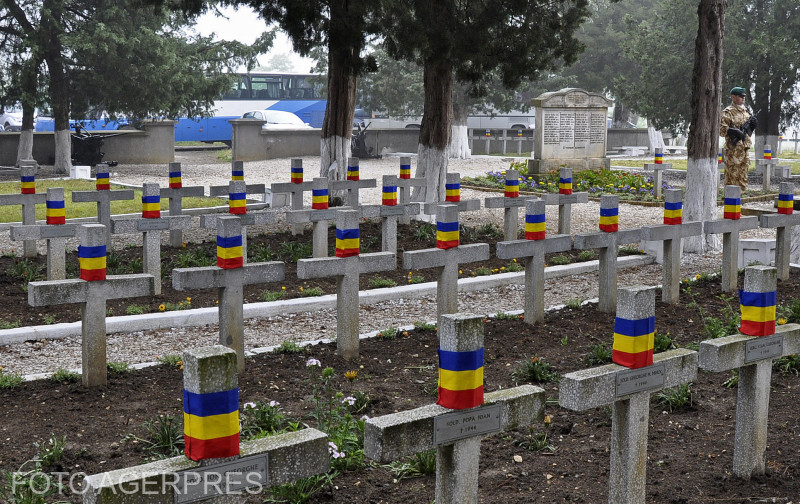
Turtucaia, Cotul Donului or Flămanda are the names of the places of some of the biggest military disasters that the Romanian army has suffered over time. Along with these names, the Battle of Orba de Mures during World War II also deserves its place on this sad list.
Although this event was less known to the general public, it was shocking primarily because it could have been so easily avoided.
In Oarba de Mures, Romanian soldiers were almost deliberately sacrificed while under foreign command, which makes the event even darker.
The context of the battle of Orba de Mures and the situation at the front after August 23, 1944.
On August 23, 1944, Romania would withdraw from the alliance with Germany and join the Allies, a rather controversial act today. His motivations stemmed from the disaster caused by the breakthrough of the front at the Don bend, which was followed by the inexorable advance of the Soviet forces, as the German-Romanian forces were unable to offer effective resistance.
There is no doubt that Romania’s breaking of the alliance with Germany shortened the war by months, significantly weakening the forces on this part of the front.
Although Romania was theoretically an ally of the USSR, after August 23 the Russians delayed signing the cessation of hostilities until they were sure of occupying the entire country. In addition, the behavior of the Red Army was deplorable, the Soviet Union behaved like a conqueror, not an ally.
In addition to the robberies, rapes and murders that were part of their usual arsenal, the Russians captured about 150 thousand soldiers of the Romanian army, who had disarmed, and sent them to the USSR
Subsequently, large parts of the Romanian army were subordinated to the Soviet troops under the command of the 2nd Ukrainian Front. It is known that the Russians assigned only the most difficult tasks to the poorly equipped and armed Romanian troops.
Starting from September 1944, Romanian units, together with Russian units, attacked the retreating Germans, driving them back to the border with Hungary.
But the Soviet Union distrusted the Romanian army. At the same time, they could not forgive the fact that in the summer of 1941, the Romanians, together with the Germans, participated in the invasion of the USSR to liberate Bessarabia and Bukovina, illegally occupied by them a year earlier.
As a result of this state of affairs, many officers who distinguished themselves in battles were dismissed and replaced by cadres of Tudor Volodymyrescu’s division of traitors.

Monument to Heroes – Orba de Mures (Photo: Agerpres)
The conduct of the battle and the defeat of the Romanian troops
Orba de Mures is a small settlement in the county of Mures, which belongs to the city of Iernut. In the second half of September – the first days of October 1944, the fighting reached this area. Here, units of the German 8th SS Cavalry Division managed to create a powerful defensive element on the crest of the Sangeorjiu hill. The Romanian troops of the 9th and 11th Infantry Divisions in the area were part of the 6th Army Corps, which was under the command of Soviet General Serhiy Trofimenko.
The Romanians greatly outnumbered the German division, but were poorly equipped, and the tactical position favored the latter.
The Romanian command proposed to cover the enemy positions from the flanks in the direction of Turda and Mures, so that the Germans would then be surrounded and forced to surrender. It was the best strategic decision that could have been made, and would most likely have been successful with minimal loss of life.
The proposals of the Romanian officers were rejected by the Soviet command, especially General Trofimenko. He showed clear distrust of the Romanian army. There are also voices that claim that the order to cross Mures and attack German positions from the front was also behind the Russian decision to weaken the Romanian army.
According to the decision of the Soviet commander Serhii Trofimenko, the Romanians were sent to force Mures without logistical support and without a bridge. Later they were forced to attack German positions on steep hills. The Romanian army was literally cannon fodder for the German positions.
Between September 22 and 25, Romanian troops launched a series of successive frontal attacks on the fortified hills from Oarba de Mures, on a front of only 400 meters, the losses were hallucinatory, approximately 11 thousand soldiers lost their lives in these suicidal attacks.
After seven such unsuccessful frontal assaults, the solution proposed by the Romanians, bypassing the enemy from the flank, was finally accepted. Fighting continued until about October 6, 1944, when the Germans were finally forced to retreat.

Cemetery of the Roman heroes of the Second World War in the town of Orba de Mures (photo: Agerpres)
The Soviet general’s controversial decision to attack frontally
There was much controversy surrounding the Battle of Orbe de Mures. During the communist period, there were very few works on this topic, as it could spoil relations with the “great friend from the east”. Thus, this battle was seen as a minor element of the liberation campaign of Transylvania.
It is fair to ask why General Trofymenko made the unfortunate decision to send Romanian troops into a frontal offensive. In this regard, there are several options.
First of all, we have to take into account Soviet military thinking, which we see even today, in the context of the war in Ukraine. The truth is simple, Russian commanders were not taught that they should minimize their losses, the lives of soldiers have no value for them.
In addition, there is an opinion that the Russians were not interested in maintaining Romanian troops, but only used them to maintain their own army.
There is also a third version, probably the darkest. Here we mean those voices who claim that the sending of the 9th and 11th Infantry Divisions on such a difficult mission was an act intended to inflict the greatest possible losses on the Romanian military potential.
The motivation for such a criminal gesture can be different: from revenge for the behavior of the Romanian army in Russia to the intention to destroy undesirable elements from the Romanian army.
The weakened Romanian army would no longer be able to put up any resistance after the establishment of Soviet power in the country, after the war.
The testimony of one survivor of the battle, given in an interview in the oral history archive of Radio Romania, is absolutely disturbing.
“In the summer of 1965 or 1966, I was at sea, in Efor. And a German came with a wounded hand, it was obvious that he was also wounded in the leg. And I asked him: “Where did you get hurt?” He says: “To you, to Orba de Mures”. He was a lieutenant. He knew a little Romanian. He asked me: “Where did you shoot?” Where was your goal?”
I say: “At the brick factory.” And he told me: “My enemy, I had a command post right at the Brick Factory, right there!” Running into a former enemy was a one in a million chance.
And we only discussed the issue of the war and the blind man of Mures. And she said to me:
“I did not think that you Romanians were so stupid, so limited, to attack those hills, to cross the Mures, which is fast there, to attack those hills, when you had the opportunity to attack from the flank, or below, or above. We never understood you because we felt sorry for killing your soldiers. We were spared… You had about three divisions in that sector, and we had two or three battalions. That’s how thin our defense was, but equipped with highly effective weapons. We felt sorry for how you sent soldiers to their deaths, and we never understood…”
I told him by order of the Soviet general. And the German lieutenant said to me: “Now I understand what the Soviet troops did to the Poles in Katyn, they did to your soldiers (in Orba de Mures). Your soldiers killed you at Oarba de Mures because they did not have the opportunity to clear your army…”.
Literature:
– Liddell Hart – History of World War II
– Constantin Sănătescu – Diary of General Sănătescu 1941-1947
– Ioan Scurtu – Romania during World War II
– To Dino C. Jurescu – Romania in the Second World War: (1939 – 1945)
Read other articles by Andrii Stan:
- Finn, who enlisted in three armies to fight against one enemy. How Laurie Torney became the subject of books and films
- “Not a step back”: the famous Stalin’s order 227 and blockade special forces
- Battle of Wizna or “Polish Thermopylae”
- The story of Andriy Vlasov, Stalin’s successful general who defected to the Germans: traitor or anti-communist?
- Who was Stepan Bandera: a hero for Ukraine, a terrorist for Russia/ Putin mentioned in his speech on Victory Day
- How war propaganda works: from the genocide in Rwanda to the Russian invasion of Ukraine
- Lend-Lease or how the USA helped Russia not to disappear Genocide of Ukrainians, which Russia would like to forget.
- Russia’s behavior then and now: from Katyn to Buchi, or how Russian propaganda tries to change history
- The Battle of Turtukaia is one of the most shameful defeats in the history of the Romanian army
- The history of two Chechen wars: Russia “wanted” and then “quick and clean” intervention
- Why the Russian blitzkrieg failed in Ukraine. Will the Ukrainian army be able to resist the Russian invasion like the Finns in 1939?/ Similarities and differences
Source: Hot News RO
Robert is an experienced journalist who has been covering the automobile industry for over a decade. He has a deep understanding of the latest technologies and trends in the industry and is known for his thorough and in-depth reporting.